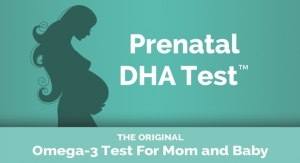05.15.19
OmegaQuant’s Omega-3 Index and Prenatal DHA test kits are now registered in the EU as in vitro diagnostic medical devices. They are also CE-marked, which is the regulatory approval it needs to sell into Europe. Thus, these tests are now accessible in Europe, as well as in the U.S. and Asia-Pacific.
CE marking is the medical device manufacturer’s claim that a product meets the essential requirements of all relevant European Medical Device Directives. These Directives outline the safety and performance requirements for medical devices in the EU.
OmegaQuant is partnering with the Nutritional Analytical Service at the Institute of Aquaculture at the University of Stirling, Scotland, to carry out the analysis of its omega-3 tests coming in from European consumers.
“We are partnering with the University of Stirling to run our testing methods in their laboratory,” said Jason Polreis, CEO, OmegaQuant. “This way we are offering the same accurate, precise and scientifically validated methods at our three laboratories covering North America, Asia-Pacific and now Europe.”
“We have had clients ask how they can get our omega-3 test panels in Europe and this will now allow us to service them and provide results in a timelier manner,” Polreis added. “We are looking forward to bringing an at-home collection kit to the EU market to make access to the Omega-3 Index and Prenatal DHA tests convenient, so individuals can personalize their omega-3 intake.”
Welcoming the announcement, James Dick, NAS technical manager, said: “We are delighted to work with OmegaQuant to provide this important service to their European customers. This partnership recognizes the internationally-renowned expertise of both partners in testing for omega-3 fatty acids and we are looking forward to developing this exciting new partnership.”
The Omega-3 Index test measures the amount of omega-3s EPA and DHA in the blood and it has been used in more than 200 clinical studies. The Prenatal DHA Test is a new offering from OmegaQuant, which measures DHA specifically in the blood. It was launched in February based on research that a certain level of DHA in the blood can significantly reduce a pregnant woman’s risk of preterm birth.
CE marking is the medical device manufacturer’s claim that a product meets the essential requirements of all relevant European Medical Device Directives. These Directives outline the safety and performance requirements for medical devices in the EU.
OmegaQuant is partnering with the Nutritional Analytical Service at the Institute of Aquaculture at the University of Stirling, Scotland, to carry out the analysis of its omega-3 tests coming in from European consumers.
“We are partnering with the University of Stirling to run our testing methods in their laboratory,” said Jason Polreis, CEO, OmegaQuant. “This way we are offering the same accurate, precise and scientifically validated methods at our three laboratories covering North America, Asia-Pacific and now Europe.”
“We have had clients ask how they can get our omega-3 test panels in Europe and this will now allow us to service them and provide results in a timelier manner,” Polreis added. “We are looking forward to bringing an at-home collection kit to the EU market to make access to the Omega-3 Index and Prenatal DHA tests convenient, so individuals can personalize their omega-3 intake.”
Welcoming the announcement, James Dick, NAS technical manager, said: “We are delighted to work with OmegaQuant to provide this important service to their European customers. This partnership recognizes the internationally-renowned expertise of both partners in testing for omega-3 fatty acids and we are looking forward to developing this exciting new partnership.”
The Omega-3 Index test measures the amount of omega-3s EPA and DHA in the blood and it has been used in more than 200 clinical studies. The Prenatal DHA Test is a new offering from OmegaQuant, which measures DHA specifically in the blood. It was launched in February based on research that a certain level of DHA in the blood can significantly reduce a pregnant woman’s risk of preterm birth.


























